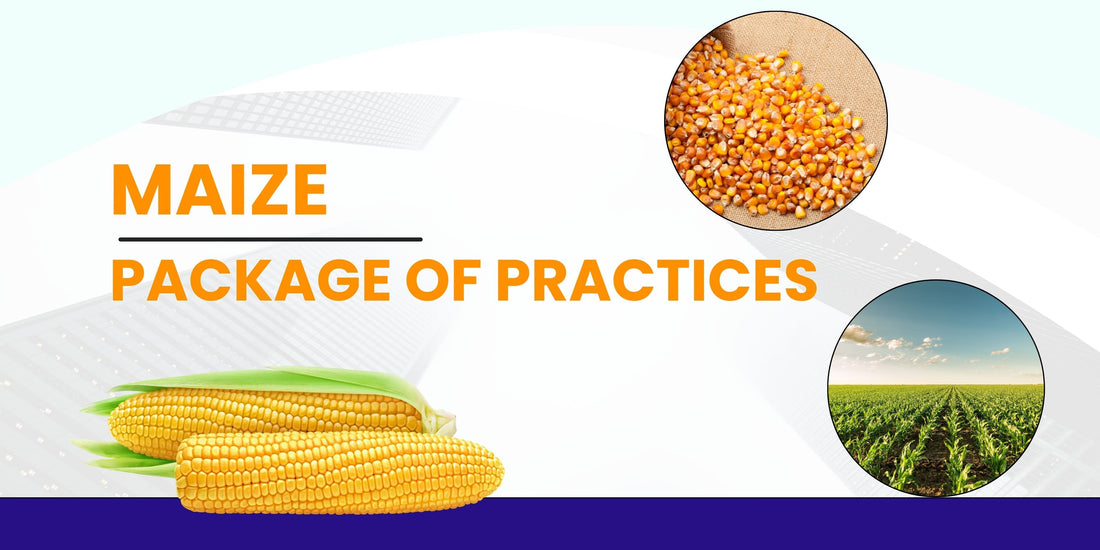
MAIZE PACKAGE OF PRACTICES
Maize (Zea mays L.)
Maize is one of the most important cereal crop in the world used as food and feed. It has very high yield potential. There is no cereal on the earth which has so immense potentiality and that’s why it is called ‘Queen of Cereals’. Maize is grown in almost all the states of India. It is next to rice, wheat and sorghum with regards to area and production in India. The following package of practices has to be adopted to achieve higher yields during Kharif and Rabi.
Soil and Climate
- Maize is best suited to well drained sandy loam to silty loam soils. Water stagnation is harmful to the crop, therefore, proper drainage is a must for success of the crop especially during kharif season. Optimum pH ranges between 5.5 and 7.5. The alluvial soils are very suitable for growing maize crop.
- Maize is warm weather plant. It grows from sea level to 3000m altitude. It can be grown under diverse conditions. It is grown in many part of the country. Kharif season is main growing season in northern India. In the south, however maize is sown any time from April to October. The most suitable temperature for germination is 21oC and for growth 32oC. Extremely high temperature and low humidity during flowering damages the foliage, desiccates the pollen and interferes with pollen germination.
Time of sowing:
Kharif: June 15th to July 15th. In case of delayed monsoon, sowings may be extended up to first week of August using short duration hybrids under assured irrigation facilities.
Rabi: October 15th to November 15th in Telangana and Rayalseema districts and up to January 1st week in coastal districts of Andhra Pradesh.
METHOD OF PLANTING
- Seed treatment: Treated with Bavistan@ 3gm/Kg of seeds before sowing in the field.
- Depth of Sowing: 4-6 cm, where maize is generally sown on flat beds.
- Spacing: 70cm x 25cm for row to row and plant to plant 4. Plant density of 66,666/ha.
- A healthy seeds of 20-22Kg required for cultivation in one hectare of land.
Method of sowing: Sowing on sides of ridges at a distance of 1/3rd from top facilitates irrigation as well as drainage. Excess seedlings should be thinned 10 days after emergence to have single seedling per hill.
Fertilizers
A well prepared flat-bed which has given 4-5 deep ploughing provided an ideal condition for sowing of crop.
- FYM or compost: 5 tonne / ha
- N: 100-120 Kg
- P2 O5: 60 Kg
- K2O/ 30-40 Kg Urea should be applied in 3 splits, mainly at sowing, knee-high and tasselling stages.
Entire dose of P & K2O with 40 Kg urea should be applied at the time of sowing. Application of 25 Kg of ZnSO4at sowing is also recommended since maize is susceptible to Zn deficiency.
Weeding
Pre-emergence spraying with Atrazine 50 W.P. @ 800 -1200 g/ac depending on soil type and at 30 days after sowing, spraying of 2,4-D Sodium salt 80 WP @ 500 g/ac in 200 litres of water will control most of the broad leaved weeds effectively. After 30-35 days, crop may be inter-cultivated and earthing up should be done. Atrazine is recommended when maize is grown as a pure crop only.
Earthing up
One earthing up may be given along with first weeding at 30-35 days after sowing to protect the plant from lodging.
Irrigation
Though the crop is grown under rainfed conditions, if drought occurs during flowering stage, irrigation helps to give good yields. When the crop is in initial stages, provide proper drainage facilities to drain out excess water in case of heavy down pour.Four to six irrigations are needed during the Rabi season. If six irrigations are given, they should be applied at the following crop growth stages. Two irrigations up to flowering at an interval of 20-25 days, one at the time of flowering, two after flowering and one at the early grain filling stage. If five irrigations are given, one irrigation at the vegetative stage may be avoided and if only four irrigations are given, one irrigation after the dough stage may be avoided. The irrigation schedule may however be changed suitably based on the soil conditions.
Critical interventions:
- Maintaining optimum plant population of 33,333 plants/acre.
- Plant protection measures against stem borer within 10-12 days after germination.
- Keeping the crop weed free up to 45 days.
- Top dressing of urea coinciding with the rains in Kharif.
- Irrigation at silking, milky and dough stages.
Zero tillage maize
- No preparatory tillage
- Dibble the seed after harvesting Kharif rice at 2-3 cm depth, in optimum moisture, or else, give light irrigation before dibbling depending on the soil type.
- Practice Line-sowing by adopting a spacing of 60x20 cm.
- Spray Gramoxone 1.0 l/acre (5 ml /l) to prevent the regrowth of rice stubbles.
- Spray Atrazine 800g - 1.2 kg/acre (4 g/l) immediately after sowing or next day to prevent broad leaved weeds.
- Combination of Gramoxone 1.0 l/ac and Atrazine 1.0 kg/ac can also be used for controlling regrowth of rice stubbles and broad-leaved weeds.
- Ensure proper moisture at the time of spraying herbicide Intercultivation and earthing up to be practiced at 25-30 DAS A recommended dose of 100-32-32 kg N-P2O5-K2O per acre is applied.
- Entire Phosphorous as basal, nitrogen in four splits viz., at sowing, knee high stage (30-35 DAS), at flag leaf emergence (50-55 DAS) and at tasseling-silking stage (60-65DAS) and potassium in two splits i.e., basal and flowering stage.
- The fertilizers should be applied through placement method for better utilization of nutrients.
- Provide 5-6 irrigations based on the soil type and climatic conditions.
- Adopt need based plant protection measures like normal maize.
Intercropping:
Growing of one row of soybean in between 2 rows of maize (60 cm spacing) gave increase in yield of maize.The planting of one row of Maize alternating every 4 rows of Urdbean or black gram (30cm spacing) is found to be most suitable, resulted in the highest productivity.
Pest management:
1.Stem borer (Chilo partellus)

- The maize stem borer attacks every part of maize plant. Newly hatched larvae scrap the central leaves of the whorl and soon tunnel into the stem through the whorl.
- The new emerging leaves of the whorl show small pinholes and called as shot hole injury. Grown up larvae produce bigger holes in the whorl leaves, the severe attack results in drying of central whorl of the plant, which is called “dead heart”.
- The plants showing dead hearts do not show usual leaf injury symptoms, remain stunted in growth and no flowering takes place.
- The larvae also damage the emerging tassels, silk and developing grains on the cobs and pupate inside the stem. The major loss in grain yield is due to dead-hearts and stunting of growth.
Management
Cultural - Deep ploughing in the month of March/April. Destruction of the crop residues of previous crop. Early planting in the month of March/April.
Control Measures –
- Spraying of lantana extract 10% and Panchgavya 5% is effective in control. 2-3 Prophylactic spray of neem oil (3%) starting before cob emergence.
- For effective control of caterpillar LARVEX 250 ml/acre can be used.
2.Cut worm (Agrotis ipsilon)

Symptoms - Cutworms are nocturnal in habit. The larval colour varies from light glossy to grayish black or brown. The larvae feed at night and plants are cut at or below the surface of the ground. This is generally observed during pre kharif and Rabi seasons. It cuts the emerging seedlings at the base of the shoot results in complete loss.
Management
Cultural - Collection and destruction of the grown up larvae of cutworms.
Control measures –
- Application of neem cake @ 250kg/ha along with compost.
- Soil application of Metarhizium anisopliae and Bauveria bassiana @1x1012 viable spores/ha as soil treatment.
- For effective control of caterpillar LARVEX 250 ml/acre can be used.
Disease management:
1.Turcicum leaf blight (TLB) (Exserohilum turcicum)

(formerly - Helminthosporium turcicum)
Symptoms - It occurs during May to September. Long, elliptical, grayish green or tan lesions (2.5- 15 cm) appear on lower leaves progressing upward. At later stages the spots will become cigar-shaped and 3 to 15 cm long. At the final stages the spots become elliptical and tan colour, developing dark areas as they mature that are associated with fungal sporulation. The disease is prevalent in cooler condition with high humidity
Management
Seed treatment with T. harzianum (6 g/kg of seeds) and 2 sprays of 3% Nimbicidin at 40 and 50 DAS. Seed treatment with T. harzianum and three sprays of lime sulphur at 30, 40 and 50 days interval.
2.Maydis leaf blight (MLB) (Bipolaris maydis)

Symptoms - It occurs during May to September. Lesions on the leaves elongated between the veins, tan with buff to brown or dark reddish brown borders. Lesion size may vary in inbreds and hybrids due to different genetic background.
Management
Grow recommended maize varieties/hybrids for the region like VL-42, Prabhat, KH-5901, PEMH-1, PEMH-2, PEMH-3.
3.Downy mildews (DM)

Symptoms - The main symptoms of downy mildew are legends developing on lower leaves as narrow chlorosis strips. Strips extend in parallel fashion, well defined margined delimited by veins. Downy whitish to creamy growth usually on the ventral surface of the infected leaves appears corresponding to stripes.
Management - The infected plants should be rogue out and destroyed. The planting of crop before onset of rains minimizes the incidence of mildew
Harvesting and threshing:
Maize is ready for harvesting even when the stacks and leaves are somewhat green but the husk cover has dried and turned brown. Shell Maize when the moisture content ranges between 15-20%. Conventional harvestor combines can be used for threshing Maize with husk to save labour involved in dehusking. The Maize ears should preferably be dried for 3-4 days after harvesting to improve grain recoveries and reduce breakage losses during shelling.
Yield
A good crop of maize produces a grain yield of about 4.0 to 5.0t/ha under organic production system.
